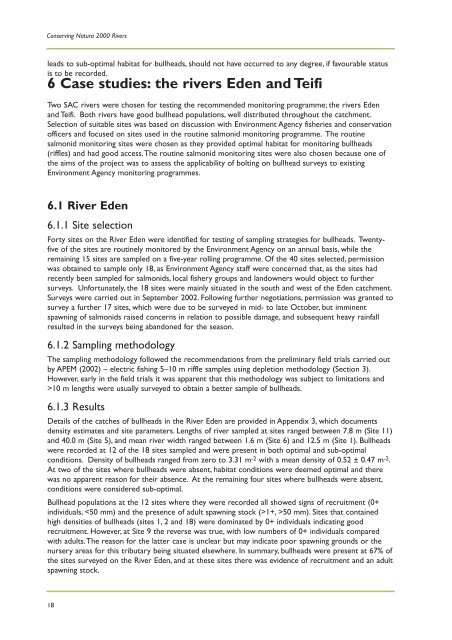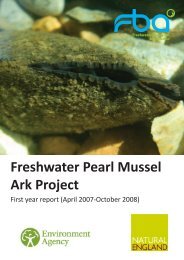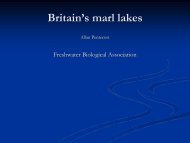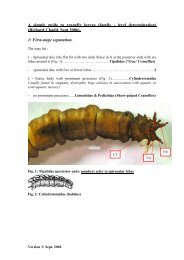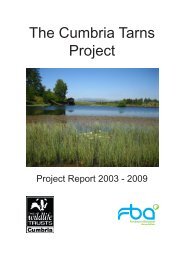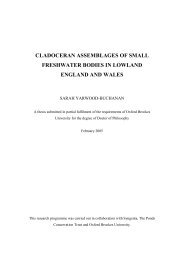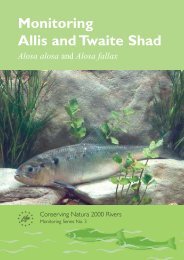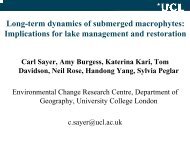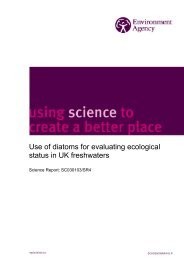Monitoring the Bullhead - European Commission
Monitoring the Bullhead - European Commission
Monitoring the Bullhead - European Commission
Create successful ePaper yourself
Turn your PDF publications into a flip-book with our unique Google optimized e-Paper software.
Conserving Natura 2000 Rivers<br />
leads to sub-optimal habitat for bullheads, should not have occurred to any degree, if favourable status<br />
is to be recorded.<br />
6 Case studies: <strong>the</strong> rivers Eden and Teifi<br />
Two SAC rivers were chosen for testing <strong>the</strong> recommended monitoring programme; <strong>the</strong> rivers Eden<br />
and Teifi. Both rivers have good bullhead populations, well distributed throughout <strong>the</strong> catchment.<br />
Selection of suitable sites was based on discussion with Environment Agency fisheries and conservation<br />
officers and focused on sites used in <strong>the</strong> routine salmonid monitoring programme. The routine<br />
salmonid monitoring sites were chosen as <strong>the</strong>y provided optimal habitat for monitoring bullheads<br />
(riffles) and had good access.The routine salmonid monitoring sites were also chosen because one of<br />
<strong>the</strong> aims of <strong>the</strong> project was to assess <strong>the</strong> applicability of bolting on bullhead surveys to existing<br />
Environment Agency monitoring programmes.<br />
6.1 River Eden<br />
6.1.1 Site selection<br />
Forty sites on <strong>the</strong> River Eden were identified for testing of sampling strategies for bullheads. Twentyfive<br />
of <strong>the</strong> sites are routinely monitored by <strong>the</strong> Environment Agency on an annual basis, while <strong>the</strong><br />
remaining 15 sites are sampled on a five-year rolling programme. Of <strong>the</strong> 40 sites selected, permission<br />
was obtained to sample only 18, as Environment Agency staff were concerned that, as <strong>the</strong> sites had<br />
recently been sampled for salmonids, local fishery groups and landowners would object to fur<strong>the</strong>r<br />
surveys. Unfortunately, <strong>the</strong> 18 sites were mainly situated in <strong>the</strong> south and west of <strong>the</strong> Eden catchment.<br />
Surveys were carried out in September 2002. Following fur<strong>the</strong>r negotiations, permission was granted to<br />
survey a fur<strong>the</strong>r 17 sites, which were due to be surveyed in mid- to late October, but imminent<br />
spawning of salmonids raised concerns in relation to possible damage, and subsequent heavy rainfall<br />
resulted in <strong>the</strong> surveys being abandoned for <strong>the</strong> season.<br />
6.1.2 Sampling methodology<br />
The sampling methodology followed <strong>the</strong> recommendations from <strong>the</strong> preliminary field trials carried out<br />
by APEM (2002) – electric fishing 5–10 m riffle samples using depletion methodology (Section 3).<br />
However, early in <strong>the</strong> field trials it was apparent that this methodology was subject to limitations and<br />
>10 m lengths were usually surveyed to obtain a better sample of bullheads.<br />
6.1.3 Results<br />
Details of <strong>the</strong> catches of bullheads in <strong>the</strong> River Eden are provided in Appendix 3, which documents<br />
density estimates and site parameters. Lengths of river sampled at sites ranged between 7.8 m (Site 11)<br />
and 40.0 m (Site 5), and mean river width ranged between 1.6 m (Site 6) and 12.5 m (Site 1). <strong>Bullhead</strong>s<br />
were recorded at 12 of <strong>the</strong> 18 sites sampled and were present in both optimal and sub-optimal<br />
conditions. Density of bullheads ranged from zero to 3.31 m-2 with a mean density of 0.52 ± 0.47 m-2. At two of <strong>the</strong> sites where bullheads were absent, habitat conditions were deemed optimal and <strong>the</strong>re<br />
was no apparent reason for <strong>the</strong>ir absence. At <strong>the</strong> remaining four sites where bullheads were absent,<br />
conditions were considered sub-optimal.<br />
<strong>Bullhead</strong> populations at <strong>the</strong> 12 sites where <strong>the</strong>y were recorded all showed signs of recruitment (0+<br />
individuals, 1+, >50 mm). Sites that contained<br />
high densities of bullheads (sites 1, 2 and 18) were dominated by 0+ individuals indicating good<br />
recruitment. However, at Site 9 <strong>the</strong> reverse was true, with low numbers of 0+ individuals compared<br />
with adults.The reason for <strong>the</strong> latter case is unclear but may indicate poor spawning grounds or <strong>the</strong><br />
nursery areas for this tributary being situated elsewhere. In summary, bullheads were present at 67% of<br />
<strong>the</strong> sites surveyed on <strong>the</strong> River Eden, and at <strong>the</strong>se sites <strong>the</strong>re was evidence of recruitment and an adult<br />
spawning stock.<br />
18


